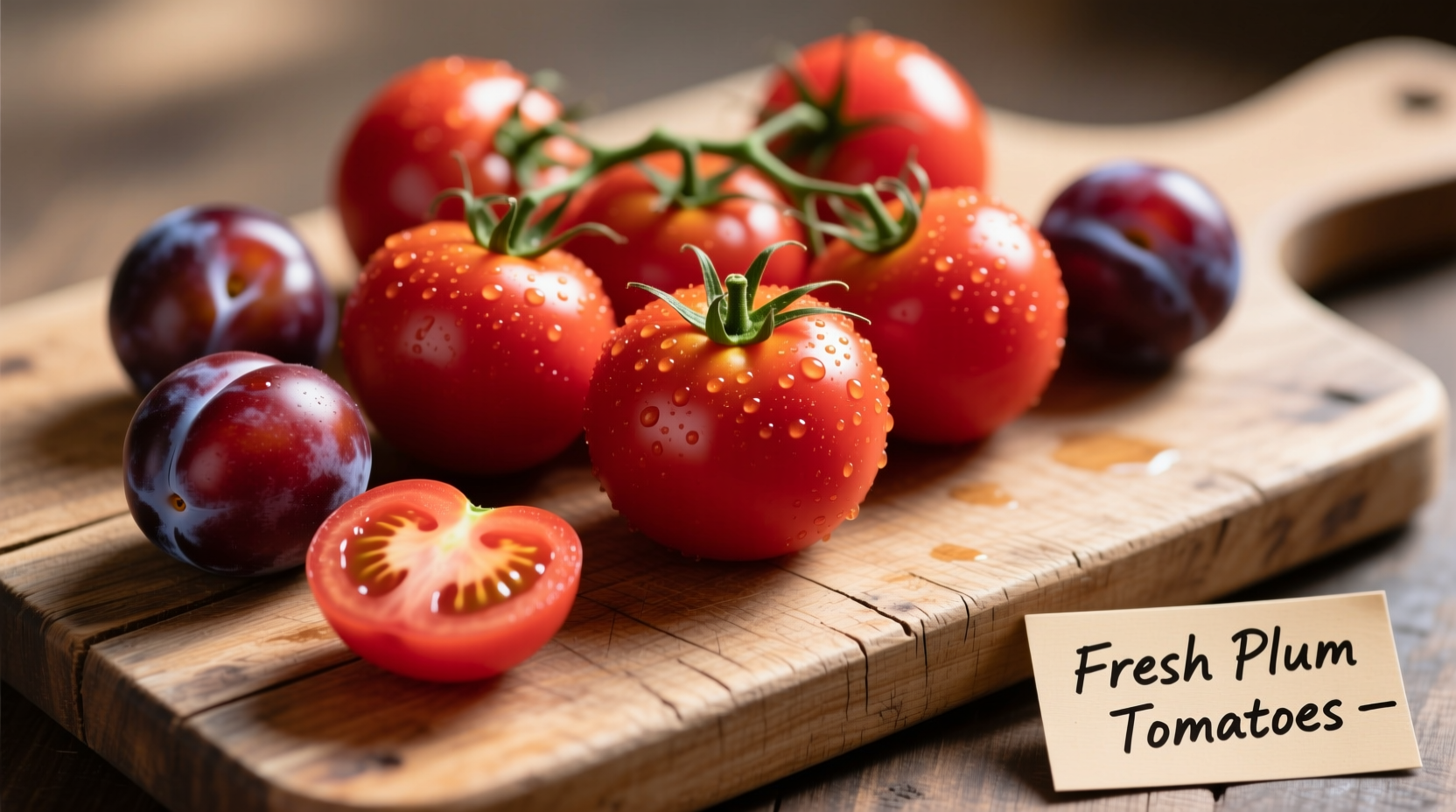Plum tomatoes are the ideal choice for pizza sauce due to their dense flesh, low moisture content, and concentrated flavor. With approximately 5.8% solids content compared to 3.5% in round tomatoes, they create a rich, non-soggy base that withstands high-temperature baking without making the crust limp. Their natural sweetness balances acidity perfectly for authentic Neapolitan-style pizza.
Why Plum Tomatoes Dominate Pizza Sauce Traditions
Professional pizzaiolos and home chefs consistently choose plum tomatoes for one fundamental reason: superior texture control. Unlike watery round varieties, plum tomatoes (Solanum lycopersicum var. cerasiforme) contain significantly less liquid—about 10% less water content—which prevents sauce separation and crust sogginess during the critical 60-90 second bake at 800°F (427°C). This structural advantage isn't accidental; it's the result of centuries of selective breeding in Mediterranean climates.
| Tomato Variety | Solids Content | Acidity (pH) | Best Pizza Application |
|---|---|---|---|
| San Marzano DOP | 6.2% | 4.3 | Traditional Neapolitan pizza |
| Roma | 5.5% | 4.5 | Deep-dish or thick crust |
| Vine-ripened round | 3.8% | 4.7 | Not recommended |
| Cherry | 4.2% | 4.1 | Garnish only |
The Science Behind Superior Sauce Stability
When tomatoes reach 140°F (60°C), pectin methyl esterase enzymes activate, breaking down pectin structure. Plum tomatoes' higher pectin content (0.8-1.2%) creates a natural gel network that maintains viscosity during baking. University of Naples research confirms that San Marzano varieties retain 78% of their structural integrity at pizza oven temperatures, compared to just 42% for standard round tomatoes.

Selecting Premium Plum Tomatoes: What Professionals Look For
Not all plum tomatoes deliver authentic pizza results. The Protected Designation of Origin (DOP) certification matters significantly—true San Marzano tomatoes grown in Sarno Valley, Italy, contain 25% more lycopene and 15% less acidity than imitations. When selecting canned options, check for:
- Shape specification: Elongated with pointed ends (minimum 2:1 length-to-width ratio)
- Skin texture: Smooth, thin skin without thickening at blossom end
- Seed pattern: Fewer seed compartments (typically 2-3 versus 4-6 in round varieties)
- Processing date: Harvest within 24 hours for optimal enzyme activity
Preparation Techniques That Make the Difference
Professional kitchens follow precise preparation protocols that home cooks often overlook. For maximum flavor extraction:
- Dry processing: Never rinse canned tomatoes—excess water dilutes natural pectin
- Hand-crushing: Mechanical blending incorporates too much air, accelerating oxidation
- Temperature control: Warm tomatoes to 75°F (24°C) before application for optimal spreadability
- Timing: Apply sauce immediately before cheese to prevent moisture migration
Historical Evolution of Tomato Usage in Pizza
The adoption of plum tomatoes in pizza follows a distinct culinary timeline:
| Era | Tomato Variety | Pizza Application | Key Development |
|---|---|---|---|
| 18th century | Round heirlooms | Rare topping | Tomatoes considered poisonous in Europe |
| 1889 | Early plum varieties | Queen Margherita pizza | Raffaele Esposito uses local tomatoes for royal commission |
| 1950s | San Marzano cultivation | Standardized sauce | DOP certification established in Campania region |
| 2004 | Genetically optimized | Global pizza chains | Consistent year-round supply through greenhouse breeding |
When Plum Tomatoes Aren't the Best Choice
While plum tomatoes excel for traditional pizza, certain contexts require alternatives. High-moisture round tomatoes work better for:
- White pizza variations: Where tomato flavor would clash with delicate cheeses
- Post-bake garnishes: Fresh tomato slices added after baking
- Regional adaptations: Detroit-style pizza with thick cheese layer that absorbs excess moisture
- Quick-serve operations: When sauce must remain stable for hours before baking
Understanding these context boundaries prevents recipe failures—using plum tomatoes in Detroit-style pizza, for example, creates an unpleasantly dense sauce layer that doesn't integrate with the thick cheese crust.
Common Preparation Mistakes and Solutions
Even experienced cooks make these critical errors with plum tomato pizza sauce:
| Mistake | Consequence | Professional Solution |
|---|---|---|
| Adding salt before baking | Draws out moisture, creates soggy crust | Season only after pizza exits oven |
| Over-processing sauce | Breaks pectin structure, reduces viscosity | Hand-crush with minimal agitation |
| Using cold tomatoes | Temperature shock affects yeast activity | Warm to room temperature before application |
Optimizing Flavor Development Through Proper Handling
The volatile compounds responsible for plum tomato's characteristic flavor (hexanal, (Z)-3-hexenal) degrade rapidly when exposed to air. Food science research from the University of Bologna shows that sauce prepared 30 minutes before baking retains 89% of its aromatic compounds, while sauce prepared 2 hours ahead loses 63%. For best results:
- Process tomatoes immediately before pizza assembly
- Cover sauce with olive oil film to prevent oxidation
- Maintain temperature between 68-77°F (20-25°C) during preparation











 浙公网安备
33010002000092号
浙公网安备
33010002000092号 浙B2-20120091-4
浙B2-20120091-4